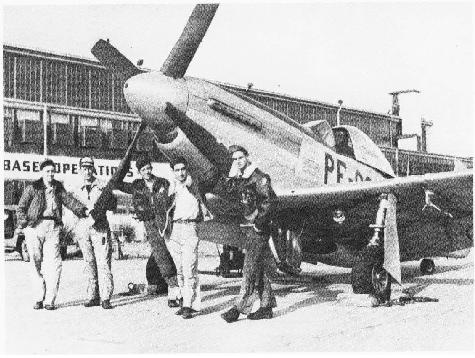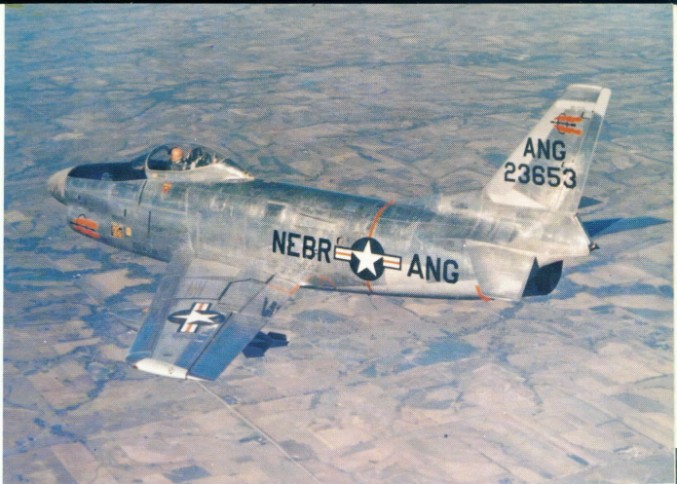




155th Wing/Squadron - 173rd Squadron Nebraska Air National Guard
The Nebraska Air National Guard was the second guard unit to stand up in the nation when it did so in February 1946. Equipped for various missions over the years stemming from fighters, interceptors, reconnaissance, and today air-refueling aircraft, the guard has stood the test of time to become an international force in Air Force operations. Today its mission takes its aircraft to various places across the globe, but it has humble beginnings operating a small number of P-51 Mustangs on the west side of the Lincoln Airport in an old World War II hangar.

A few men stand in front of a NeANG P-51 - Photo Nebraska Air National Guard
______________________________________________________
Since the establishment of the Air National Guard, an ANG unit has had a thriving life at Lincoln for beyond the past 50 years. When first created, the 173rd Fighter Squadron had P-51s (F-51s after 1947) and was stationed originally at the old Army Air Field (before Lincoln Air Force Base was re-activated). In September 1946, the Neb. ANG was equipped with 22 P-51s, 7 B-26s, 2 C-47s and 3 T-6s. These agile yet soon obsolete fighters served with the Neb. ANG until the advent of brand-new F-80Cs in July 1948.
The 173rd would transition back into F-51s at the outbreak of Korea when the F-80s were called back into active service. The 173rd itself activated during the war but only served stateside.

Nebraska F-80s in formation, note the flaming arrow on the nose - a distinctive mark of Nebraska ANG aircraft. - Photo Nebraska Air National Guard
________________________________________________________
25 "shooting stars" were based in Lincoln from 1948 until 1951 when they converted back to F-51s during the Korean War (The F-80Cs were called up for active duty service). In 1953 after de-federalization they converted back into F-80s. These were actually -A models which proved to be a problem to the 173rd for years until rebuilt by Lockheed in the mid-50s after a series of crashes.
The F-80s trained as tactical fighters until the mid 50's when an interceptor role was established and the Neber Air Guard transferred into Air Defense Command along with the rest of the 132nd Fighter Wing, based in Des Moines.

An F-86(-D,-L?) probably flying over eastern Nebraska considering the hills and landscape below. - Photo from Lincoln Air Force Base Guide
_____________________________________________________________
In July 1955, the 173rd was given the mission of Air-Interception under Air Defense Command and given F-86D Dog Sabres during the late 50's. Armed with twenty-four air-intercept rockets, the newer technology of radar and aided by ground interceptor control stations, the aircraft patrolled Nebraska's skies. Along with their active duty brethren across the runway, the interceptors stood on ground alert 24 hours a day during the height of the Cold War. In 1960, the 173rd was reorganized into the 155th Fighter Interceptor Squadron and later given F-86Ls an (updated version with better electronics and weapons) until 1964 when the mission changed to reconnaissance.

Two of Nebraska's RF-84s, an elderly aircraft by the time of NeANG service the aircraft were none the less quite capable of their mission - Photo Nebraska Air National Guard.
_________________________________________________________________
The
155th was reorganized to fly RF-84Fs in a tactical reconnaissance role during 1964 and even
though older, the Thunder-jets with Nebr. pilots out performed newer jets
at competitions.
The 155th was the last F-84 (and last first-generation fighter) unit of any type in the entire U.S. Air Force when
they were flown to Davis-Monthan in 1972. While quite capable, these aircraft were not utilized during the Vietnam War.

A side-by-side photo of Nebraska RF-4s on the ramp and one in flight. These aircraft deployed much more often than the RF-84s did to distant bases including Alaska. Photo - Nebraska Air National Guard.
____________________________________________________________
The F-84s were phased out in 1972 and the 155th was given RF-4s which flew from the 70s until 1992. The RF-4s reigned over Nebraska for the longest of all 155th/173rd aircraft and the 155th was one of the last F-4 Phantom operators in the USAF. With the end of the cold war, the overall phase-out of F-4 Phantoms and the advancement of technology, a new mission would be flown by the 155th.
155th was provided KC-135 Stratotankers in 1992 while the actual name of the unit did not change until 1994 after a transitioning period. (The KC-135 a direct descendant of both the B-47 and the KC-97 from Lincoln AFB ) which are still flown today. The 135s have served in many conflicts including Kosovo and Iraq. These aircraft are the most advanced version of the KC-135 with more efficient engines. All planes belong to the 173rd Air-Refueling squadron inside of the 155th.
Make a free website with Yola